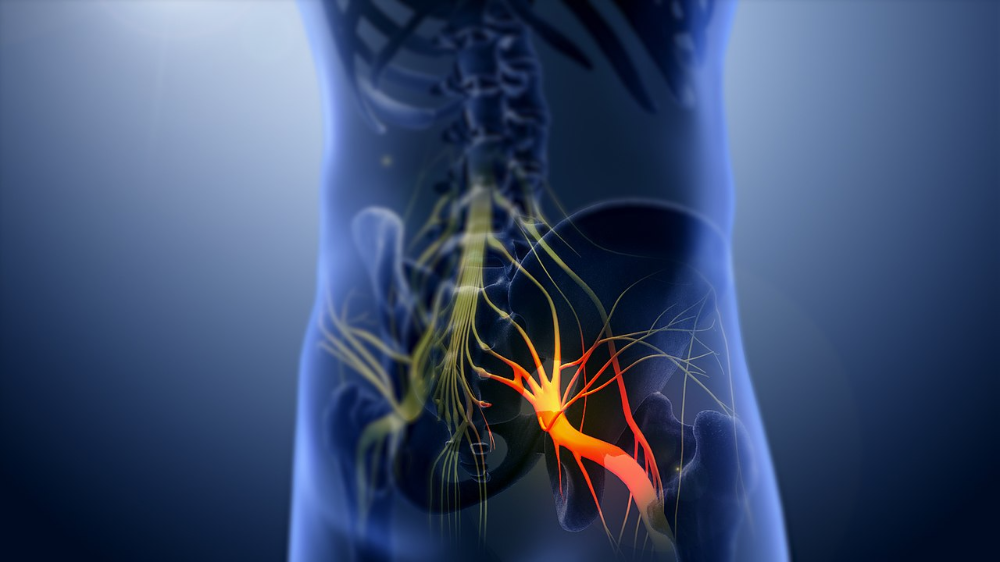The final stages of Sciatica is a condition that can occur when the sciatic nerve is irritated. The sciatic nerve runs down the back of the thigh and can be affected by a number of things, including a herniated disc, a tumor, or a compression fracture. Sciatica can cause pain and numbness in the lower leg and can be very debilitating.

Sciatica is a common condition that affects the lower back and leg. It is caused by compression of the sciatic nerve, which runs from the lower back down the back of the leg. Sciatica can cause pain and numbness in the lower leg. Sciatica is a common problem for people of all ages but is more common in older adults. Sciatica can be a sign of a more serious condition, such as a herniated disk or a spinal cord compression. If you are experiencing sciatica, see your doctor for an evaluation.
Sciatica is a condition that can be very debilitating. If left untreated, sciatica can cause intense pain down the leg, numbness, and even paralysis. The final stages of sciatica are the most dangerous, as they can lead to complete nerve damage. If you are experiencing sciatica, it is important to navigate your way through the final stages.
Understanding the Final Stages of Sciatica
Sciatica is a common condition that results from pain and inflammation in the sciatic nerve. Sciatica can be caused by a variety of factors, including herniated discs, tumors, and compression of the nerve. The final stage of sciatica is when the nerve becomes irreversibly damaged and can no longer send messages to the lower extremities. Treatment for sciatica typically involves relieving the pain and inflammation and restoring nerve function.
Symptoms of Sciatica
The most common symptom of sciatica is a sharp, shooting pain that travels down the back of the leg, often radiating to the foot or ankle. Other symptoms may include numbness, tingling, or a burning sensation in the leg.
Causes of Sciatica
Sciatica is a condition caused by compression or irritation of the sciatic nerve, typically resulting from a herniated disc, tumor, or sprain. In order to effectively treat this condition, surgery is often the most definitive option. However, other options such as physical therapy and medication may also be used to reduce inflammation and relieve pain.
Diagnosis of Sciatica
Sciatica is a condition in which pain radiates down the back of the leg. It can be caused by a variety of things, including compression of the sciatic nerve, a herniated disc, or a tumor. Treatment typically involves rest and pain relief medications.
Navigating Through the Final Stages of Sciatica
If sciatica is a longstanding pain in the back or leg, it’s likely that you’ve been through the final stages. Sciatica is a condition in which the sciatic nerve is compressed, causing pain in the lower back or leg. The final stages of sciatica are the most severe and require the most aggressive treatment.
Taking Control of Your Pain
If you are suffering from chronic pain, it is important to take control of your pain. You can do this by learning as much as you can about the cause and treatment of your pain. You should also seek out professional help if you are struggling to manage your pain. There are many different treatments available, and you should consult with a doctor or pain specialist to find the best option for you. You can also read about managing joint pain!
Medications for sciatica
There are a number of medications available for treating sciatica. Most of these medications are taken by mouth, although there are a few that can be injected. Some of the most commonly used medications for treating sciatica include:
• Naproxen (Aleve, Naprosyn, Anaprox)
• Ibuprofen (Advil, Motrin, Nuprin)
• Diclofenac (Voltaren, Cataflam, Flector)
• Sulfasalazine (Azulfidine, Azulfidine XL)
• Celebrex (Celebrex)
• Paracetamol (acetaminophen, Tylenol)
• Voltaren (Voltaren, Voltaren SR)
• Flector (Flector)
• Sulfasalazine (Azulfidine, Azulfidine XL)
• Celebrex (Celebrex)
• Paracetamol (acetaminophen, Tylenol)
• Voltaren (Voltaren, Voltaren SR)
• Flector (Flector)
• Sulfasalazine (Azulfidine, Azulfidine XL)
• Celebrex (Celebrex)
• Paracetamol (acetaminophen, Tylenol)
• Voltaren (Voltaren, Voltaren SR)
• Flector (Flector)
• Sulfasalazine (Azulfidine, Azulfidine XL)
• Celebrex (Celebrex)
• Paracetamol (acetaminophen, Tylenol)
• Voltaren (Voltaren, Voltaren SR)
• Flector (Flector)
There are also a number of over-the-counter medications that can be used to treat sciatica. These include:
• Ibuprofen (Advil, Motrin, Nuprin)
• Naproxen (Aleve, Naprosyn, Anaprox)
• Diclofenac (Voltaren, Cataflam, Flector)
• Celebrex (Celebrex)
• Paracetamol (acetaminophen, Tylenol)
• Voltaren (Voltaren, Voltaren SR)
Alternative therapies
There are many alternative therapies for sciatica, but the most common are yoga, massage, and acupuncture. Acupuncture is a form of Chinese medicine that uses tiny needles to stimulate points in the body to relieve pain. Yoga is a type of exercise that can improve flexibility and reduce pain. Massage is another common alternative therapy for sciatica. Massage can help to reduce inflammation and pain in the sciatic nerve.
Physical therapy for sciatica
Physical therapy can be very beneficial for people with sciatica. Physical therapy can help improve the range of motion, flexibility, and strength in the affected area. Additionally, physical therapy can help reduce pain and inflammation.
Maintaining a Healthy Lifestyle
There are many things that you can do to help maintain a healthy lifestyle if you are living with sciatica. One of the most important things you can do is to make sure that you are getting enough exercise. Exercise can help to reduce inflammation in the body and can also help to improve your overall mood. Additionally, you should make sure that you are eating a balanced diet. Eating a healthy diet can help to reduce the inflammation in your body and can also help to improve your mood.
Exercise
There are many ways to live with sciatica, and the best way for you to find relief is by trying different exercises and therapies. Start with gentle stretches and moves that you can do at home, and gradually increase the intensity and duration of your workouts as your condition improves. If you can’t do any of these exercises at home, you may need to see a physical therapist or chiropractor who can help you create a personalized exercise program.
Nutrition
There are many ways to help alleviate sciatica pain. Nutrition is a key part of any treatment plan. A diet that is high in fruits and vegetables, low in processed foods and saturated fats, and moderate in protein is recommended. Foods that are good sources of fiber, such as whole grains, are also beneficial. Foods that are bad for sciatica include caffeine, alcohol, and fatty foods. Some supplements that may help with sciatica include glucosamine, chondroitin, and omega-3 fatty acids.
Stress management
There are many ways to manage stress in order to live with sciatica. One way is to develop a daily routine that helps to reduce the amount of stress that is felt. Another way is to find ways to relax and de-stress. Finally, it is important to know when to seek professional help.
Seeking Support
If you are living with sciatica, then you know the pain and suffering it can cause. Sciatica is a condition that can be caused by a number of things, but it is often the result of a herniated disc. This is when a disc herniates from its normal position in the spine and presses on the nerve root, causing pain.
There is no cure for sciatica, but there are treatments that can help to improve your quality of life. One of the most important things you can do to help manage your sciatica is to seek out support. There are a number of resources available to help you, including support groups, medication, and physical therapy.
If you are living with sciatica, then it is important to find a support system that can help you to manage your pain and get the best possible quality of life.
Family and friends
There are many ways to live with sciatica. Family and friends can help to live with sciatica by providing emotional support, offering practical assistance, and providing a listening ear. It is important to remember that living with sciatica is a daily battle and that everyone experiences different levels of pain. It is also important to take care of oneself and to find ways to relax and relieve pain.
Support groups
Sciatica is a condition that affects the lower back and leg. People with sciatica often experience pain and discomfort in the lower back and leg. There are many different ways to live with sciatica, and there are many support groups available to help people feel supported. Some of the most common support groups include those for people with spinal cord injuries, people with multiple sclerosis, and people with sciatica caused by pregnancy.
There are also support groups for people who have sciatica caused by other conditions, such as carpal tunnel syndrome or lumbar disc herniation. Support groups can be a great way to connect with other people who are experiencing the same symptoms and to find resources and support.
Professional counseling
There are many effective ways to live with sciatica and professional counseling can help you find the best way to manage your symptoms. Counseling can also provide strategies to help you prevent sciatica from reoccurring in the future. Additionally, a counselor can provide you with coping mechanisms to help you manage the pain, stress, and other symptoms associated with sciatica.
Finding the Right Treatment
There is no one-size-fits-all answer to finding the right treatment for sciatica. Every person experiences pain differently and requires a different approach to managing it. Some people may find relief from traditional pain medications, while others may find relief from acupuncture or massage. It is important to find a treatment that works for you and that you can stick to.
Medical procedures
There are a variety of medical procedures that can be used to treat sciatica. These procedures can include injections, surgery, and physical therapy. Injections are the most common type of medical procedure used to treat sciatica. Injections can be used to relieve pain and inflammation. Surgery is also an option for treating sciatica. Surgery can be used to remove the source of the pain, such as a herniated disc. Physical therapy is also an option for treating sciatica. Physical therapy can help to improve the flexibility and range of motion of the spine.
Surgical options
There are a variety of surgical options for treating sciatica, including decompression, surgery to remove the herniated disc, and surgery to repair the nerve. Decompression therapy may help reduce inflammation and pain in the sciatic nerve. Surgical removal of the herniated disc may reduce pain and improve function. Surgery to repair the nerve may improve symptoms and restore function.
Integrative approach
There is no one-size-fits-all approach to treating sciatica, as the condition depends on the individual’s symptoms and history. However, an integrative approach, which includes both conventional and complementary therapies, is often the most successful. This approach may include massage, yoga, acupuncture, and other forms of physical therapy. Some people also find relief from using over-the-counter painkillers, such as ibuprofen, and from using heat and cold treatments, such as ice packs and hot baths. Some people may also benefit from using meditation or relaxation techniques.
Making the Most Out of Your Life Despite Sciatica
Sciatica is a condition that can be very frustrating. It can make it difficult to do the things you enjoy, and it can be very painful. However, there are ways to make the most of your life despite sciatica.
- First, you should make sure you are getting the treatment you need. If you are not getting relief from your sciatica, you may need to see a doctor.
- Second, you should make sure you are staying as active as possible. Even if you can’t do the things you used to be able to do, you can still make the most of your life by staying active.
- Finally, you should make sure you are taking care of your overall health. If you have other health problems, you may need to see a doctor to get them fixed. However, even if you don’t have other health problems, you can still make the most of your life by taking care of yourself.
Staying Active
There are many ways to stay active even if you have sciatica. One way is to try to do some light exercises, such as walking or swimming. Another way is to try to do some gentle stretches. If you can’t do any of those things, you can try to do some gentle exercises that focus on your back or neck.
Adaptive sports
Adaptive sports can be a great way to exercise even if you have sciatica. By incorporating adaptive sports into your routine, you can help to improve your overall fitness level and reduce the amount of pain you experience. There are many different adaptive sports options available, so it’s important to find one that is right for you. Some options that may be suitable include swimming, biking, running, and skiing. If you’re new to adaptive sports, it’s important to consult with a professional to help you choose the right option and make sure you are properly prepared.
Leisure activities
There are many different ways to enjoy leisure activities if you have sciatica. You can watch television or movies, read a book, listen to music, go for a walk, play video games, or do any other activity that you enjoy. You can also take part in group activities or activities that require physical activity. You can also try alternative therapies such as acupuncture or massage.
Finding Work-Life Balance
If you have sciatica, it can be difficult to find a work-life balance. You may find that you have to adjust your work schedule to accommodate your sciatica, or you may have to take time off work to recover. You may also find that you need to make changes to your daily routine to accommodate your sciatica.
Modifying your work environment
If you have sciatica, you may want to modify your work environment to help reduce the pain. You can try sitting in a different position, using a cushion or towel to cushion your back, and avoiding standing or sitting for long periods of time. You may also want to see a doctor to see if there is anything else you can do to reduce the pain.
Managing time effectively
If you have sciatica, managing your time can be difficult. When you have sciatica, you may find that you can’t move your leg as easily as you used to. This can make it difficult to get things done. However, there are ways to manage your time effectively if you have sciatica.
One way to manage your time is to set deadlines for yourself. When you have a deadline, you will be more likely to get things done. You can also try to schedule your time so that you have shorter blocks of time to work on tasks. This will help you to stay focused.
If you find that you are struggling to get things done, it may be helpful to talk to a doctor. They may be able to prescribe medications or recommend other ways to manage your time.
Coping with Emotional Challenges
If you have sciatica, you may find it difficult to cope with emotional challenges. This is because sciatica can cause a lot of pain and discomfort. This can make it difficult to focus on anything else. This can make it difficult to cope with stress and anxiety. It can also make it difficult to enjoy life. If you find it difficult to cope with emotional challenges, you may want to consider talking to a therapist. This can help you to deal with your emotions in a more effective way.
Accepting condition
If you have sciatica, there are a few things you can do to help relieve the pain. You can take over-the-counter pain relievers such as ibuprofen or acetaminophen, or you can see a doctor to get a prescription for something stronger. You can also try a heating pad, ice pack, or massage.
Seeking help when needed
If you are experiencing sciatica, it is important to seek help from a doctor as soon as possible. Sciatica is a condition that causes pain and numbness in the lower back and leg. If left untreated, sciatica can lead to further complications, such as paralysis. If you are experiencing sciatica, it is important to seek help from a doctor as soon as possible. Sciatica is a condition that causes pain and numbness in the lower back and leg. If left untreated, sciatica can lead to further complications, such as paralysis.
Conclusion
In conclusion, sciatica is a difficult medical condition to endure, but with the proper support and resources, it is possible to navigate through the final stages with relative ease. With the help of physical therapy, pain management, and lifestyle modifications, you can make the journey to recovery easier and more comfortable.
Additionally, it is important to remember that you are not alone and that there are many resources and support groups available to help you along the way. Finally, don’t forget to take time for yourself, be kind to your body, and have patience—the road to recovery is not an easy one, but with dedication and effort, you can get there. If you find these blogs helpful, please share this with your loved ones and friends. You are also welcome to visit our other related blog for more tips and recommendations.


